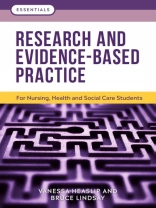Research and Evidence-Based Practice is an accessible textbook for nursing, health and social care students seeking to understand what research is and how it can provide evidence for practice.
Through clear explanations, key case studies, questions and activities, the book will help you to understand the principles of research and develop your own evidence-based practice. You will learn:
- Why research is carried out, what the aims are, and why it matters.
- How to search and review the literature and evaluate the quality of research
- How research projects are designed, how participants are recruited, how data is collected and analysed, and how research findings are communicated
- About the costs of research and how it is funded
- About the ethics of research in health and social care
- How to review evidence and how evidence is used to improve the quality of care
From reviews:
“I would definitely recommend this book to any student starting a research module or even to refresh your memories ready for your dissertations/literature reviews. The content included is everything I would want to know as a student starting a research module. The glossary at the back is great for understanding the research terminology, which can often feel like a brand new language when you first start reading research papers. There are also handy references which you can use to do further reading and enhance your critical discussion within your assignments.
The book lives up to its intention to act as a lead-in to the research topic and has a clear and concise style throughout, whilst explaining things in the amount of detail needed to fully understand them. A must read for any nursing or health and social care student!”
Review on studentnurseandbeyond.co.uk, March 2019
Essentials is a series of accessible, introductory textbooks for students in nursing, health and social care. New and forthcoming titles in the series:
- The Care Process
- Communication Skills
- Leadership
- Mental Health
- Promoting Health and Wellbeing
- Study Skills
Содержание
About the authors; Introduction
Part One: Understanding research
1. Identifying the research aim
1.1 Introduction
1.2 Why does society want health and social care research?
1.3 Why do researchers do research?
1.4 What will be studied?
1.5 Who makes the decisions?
1.6 What do we want to find out?
1.7 Achieving success
2. Reviewing the literature
2.1 Introduction
2.2 Why does a researcher need to know what’s already available?
2.3 Understanding the context
2.4 Understanding the existing evidence
2.5 Can I justify my project?
2.6 Carrying out the literature review
2.7 Developing a search strategy
2.8 Searching databases
2.9 What else should be searched?
2.10 Evaluating quality
2.11 Conclusion
3. Designing a study
3.1 Introduction
3.2 The three levels
3.3 Making sense of the levels
3.4 Paradigms
3.5 Methodologies
3.6 Method
3.7 Tools
3.8 The research hierarchies
3.9 External influences
3.10 Making the final choice
4. Can it be done? Funding and ethics
4.1 Introduction
4.2 Who funds research?
4.3 How much does research cost?
4.4 Ethical issues in health and social care research
4.5 Gaining ethical approval
4.6 Public engagement in research
4.7 Reading research — identifying ethical issues
5. Recruitment and data collection
5.1 Introduction
5.2 Recruitment issues
5.3 Participants or subjects?
5.4 Developing inclusion and exclusion criteria
5.5 Selection and sampling
5.6 Sampling
5.7 How big should the sample be?
5.8 Attrition
5.9 Obtaining consent
5.10 Giving rewards
5.11 Data collection
5.12 Data collection tools
5.13 Issues in data collection
5.14 Confidentiality and anonymity
5.15 Conclusion
6. Data analysis
6.1 Introduction
6.2 Quantitative and qualitative analysis: the same but different?
6.3 Quantitative analysis
6.4 Measurement scales
6.5 Types of statistical analysis
6.6 Major methods of quantitative analysis
6.7 Conclusion
7. What do we know now? Communicating research findings
7.1 Introduction
7.2 What can research tell us?
7.3 Limits to research accuracy
7.4 Building a body of research
7.5 Disseminating research
7.6 Conclusion
Part Two: Evidence-based practice
8. Reviewing the evidence
8.1 Introduction
8.2 Reliable, valid, relevant and applicable?
8.3 Relevance and applicability
8.4 Research synthesis
8.5 Evidence from other sources
8.6 Role of the service user
8.7 Conclusion
9. Putting the evidence into practice
9.1 Introduction
9.2 The relationship between evidence and practice
9.3 Top-down or bottom-up?
9.4 Changing personal practice
9.5 Practitioner inquiry
9.6 Action research
9.7 Conclusion
10. Audit and evaluation
10.1 Introduction
10.2 Audit and evaluation: what are they?
10.3 Differentiating between audit, evaluation and research
10.4 When to audit or evaluate
10.5 What standards matter?
10.6 Involving services users in audit and evaluation
10.7 Conclusion
11. ‘Closing the circle’: issues for the future
11.1 Introduction
11.2 The speed of change
11.3 New and forthcoming developments
11.4 Predicting, creating and dealing with change: the place of research
11.5 The international nature of health and social care
11.6 Who will be the health and social care researchers of the future?
11.7 Conclusion
Glossary; References; Index
Об авторе
Bruce Lindsay worked in health care for over thirty years after qualifying in children’s nursing and adult nursing in Sheffield. He was awarded a Ph D for his research into the development of the care of children in acute hospitals. He was a Senior Lecturer and Deputy Director of the Nursing and Midwifery Research Unit at the School of Health Sciences, University of East Anglia, until 2012, and was a systematic reviewer for Cochrane for fifteen years. He is now a freelance music journalist and biographer.












